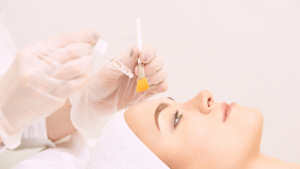Chemical Peel
Chemical Peel In Iran
Best chemical peel clinic in Iran

Millions of Iranian and foreign patients are going under treatment in Iran each month. chemical peel in Iran is on top of the middle-east regarding its skilled specialists and doctors.
Here are the best centres for a chemical peel in Iran:
- Atrisa Clinic
chemical peel cost in Iran
There is a significant difference between the cost of chemical peel in Iran and other countries. The most important factors for the low price of it in Iran are:
- A large number of chemical peel clinics in Iran.
- A large number of applicants for a chemical peel in Iran.
chemical peel cost in Iran varies depending on the doctor and the hospital. An average cost of chemical peel in Iran is 1440 dollars.
Chemical peel cost in Iran in comparison with other countries
This surgery costs $4500 in the U.S., $2300 in Europe, $1900 in Thailand and $2300 in Turkey.
Best chemical peel surgeon in Iran
More than 2M cosmetic treatments are being performed each year in Iran. Experienced Iranian doctors with an excellent record are performing the operations. One of the most important factors for choosing a good doctor for a chemical peel in Iran is a doctor has done many chemical peel treatments. You can find the best doctors for a chemical peel in Iran on our website by following their different experiences and before- after gallery.
Why should you travel to Iran for a chemical peel?
- Low cost of chemical peel in Iran
- Low cost of accommodation in Iran
- Well experienced doctors
- The high number of chemical peel in Iran
Cosmetic centres accordant with today's European standards are performing the highest quality operations in Iran. Another reason for a chemical peel in Iran is its lower cost compared to other countries.
How long should I stay for chemical peel in Iran?
About Chemical Peel
Overview of Chemical Peel
 The features of people’s faces are what make them unique. Faces are the first thing a person often sees. As people age, the skin appears dull, and the dead skin does not easily slough off. The skin that grows after a chemical peel is much smoother and younger-looking. They can be used to treat several skin problems including acne scars, ageing skin, crow’s feet, hyperpigmentation, melasma, scars, sun-damaged skin, sagging skin and wrinkles.
The features of people’s faces are what make them unique. Faces are the first thing a person often sees. As people age, the skin appears dull, and the dead skin does not easily slough off. The skin that grows after a chemical peel is much smoother and younger-looking. They can be used to treat several skin problems including acne scars, ageing skin, crow’s feet, hyperpigmentation, melasma, scars, sun-damaged skin, sagging skin and wrinkles.
Types of chemical peel
- Light peel: a mild acid, usually alpha hydroxy acids (AHA), is used to remove the outer layer of the skin. This method is used to treat fine wrinkles, acne, dryness and skin discolouration as well as to refresh the face, neck, chest or hands.
- Medium peel: Glycolic or trichloroacetic acid is used to remove the skin cells from the epidermis and upper part of the middle layer of skin (dermis). It is used to treat age spots, acne scars, wrinkles and moderate skin discolouration.
- Deep peel: trichloroacetic acid or phenol is used to remove skin cells from the epidermis and from mid to lower layer of the dermis. It is used to treat deeper wrinkles, scars, and sun-damage and age spots. The deep peel is used on the face and can only be performed once.
Recommended for:
-
Individuals with fair-skin and light-hair(But even if individuals with darker skin may have good results with chemical peel)
Before Chemical Peel
Before Cchemical peel
 Individuals must not use any retinol or Retin-A topical medication for at least 48 hours before the procedure. They should inform their skincare specialist about any medications that they take. They must not have been on Accutane for at least six months before the procedure. The skincare specialist may prescribe antibiotics or antiviral drugs. Individuals should stop using facial scrubs and exfoliants a week before the procedure. They should stop epilating, waxing or using depilatory hair removal products a week before the procedure.
Individuals must not use any retinol or Retin-A topical medication for at least 48 hours before the procedure. They should inform their skincare specialist about any medications that they take. They must not have been on Accutane for at least six months before the procedure. The skincare specialist may prescribe antibiotics or antiviral drugs. Individuals should stop using facial scrubs and exfoliants a week before the procedure. They should stop epilating, waxing or using depilatory hair removal products a week before the procedure.
During Chemical Peel
During Chemical Peel
No special consideration needed.
Recovery
After Chemical Peel
- Light peel: It has minimal discomfort. Individuals may experience some redness and dryness. It requires 1 to 7 days to heal. They must use sunscreen and lotion or cream.
- Medium peel: Individuals may experience redness and swelling. They can take some painkillers to control the pain. It is essential to avoid sun exposure until healing is complete. They should apply protective ointments. It requires 7 to 14 days to heal. The doctor may prescribe antiviral drugs for 10 to 14 days.
- Deep peel: Individuals should avoid sun exposure for 3 to 6 months. They should apply ointment for the first 14 days, and after that, they should use thick moisturiser for the next 14 days. The doctor may prescribe antiviral drugs for 10 to 14 days. It requires 14 to 21 days to heal.
